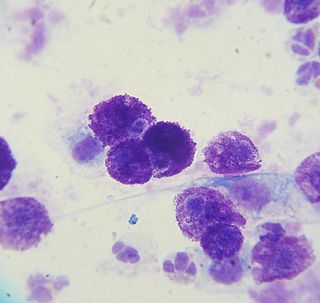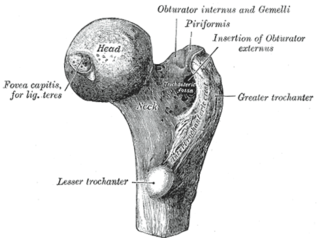Related Research Articles

A lipoma is a benign tumor made of fat tissue. They are generally soft to the touch, movable, and painless. They usually occur just under the skin, but occasionally may be deeper. Most are less than 5 cm (2.0 in) in size. Common locations include upper back, shoulders, and abdomen. It is possible to have a number of lipomas.

An osteosarcoma (OS) or osteogenic sarcoma (OGS) is a cancerous tumor in a bone. Specifically, it is an aggressive malignant neoplasm that arises from primitive transformed cells of mesenchymal origin and that exhibits osteoblastic differentiation and produces malignant osteoid.

A mastocytoma or mast cell tumor is a type of round-cell tumor consisting of mast cells. It is found in humans and many animal species; it also can refer to an accumulation or nodule of mast cells that resembles a tumor.

Canine transmissible venereal tumors (CTVTs), also called transmissible venereal tumors (TVTs), canine transmissible venereal sarcoma (CTVS), sticker tumors and infectious sarcoma is a histiocytic tumor of the external genitalia of the dog and other canines, and is transmitted from animal to animal during mating. It is one of only three known transmissible cancers in mammals; the others are devil facial tumor disease, a cancer which occurs in Tasmanian devils, and contagious reticulum cell sarcoma of the Syrian hamster.

The health of dogs is a well studied area in veterinary medicine.
Panosteitis, sometimes shortened to pano among breeders, is an occasionally seen long bone condition in large breed dogs. It manifests with sudden, unexplained pain and lameness that may shift from leg to leg, usually between 5 and 14 months of age, earning the nickname "growing pains. " Signs such as fever, weight loss, anorexia, and lethargy can also be seen. The cause is unknown, but genetics, stress, infection, metabolism, or an autoimmune component may be factors. It has also been suggested that rapid growth and high-protein food are involved in the pathogenesis. Whole blood analysis may show an elevated white blood cell count; this finding lends support to the theory that panosteitis is due to an infection.

Lymphoma (lymphosarcoma) in animals is a type of cancer defined by a proliferation of malignant lymphocytes within solid organs such as the lymph nodes, bone marrow, liver and spleen. The disease also may occur in the eye, skin, and gastrointestinal tract.
Hypertrophic osteopathy is a bone disease secondary to cancer in the lungs.

A mammary tumor is a neoplasm originating in the mammary gland. It is a common finding in older female dogs and cats that are not spayed, but they are found in other animals as well. The mammary glands in dogs and cats are associated with their nipples and extend from the underside of the chest to the groin on both sides of the midline. There are many differences between mammary tumors in animals and breast cancer in humans, including tumor type, malignancy, and treatment options. The prevalence in dogs is about three times that of women. In dogs, mammary tumors are the second most common tumor over all and the most common tumor in female dogs with a reported incidence of 3.4%. Multiple studies have documented that spaying female dogs when young greatly decreases their risk of developing mammary neoplasia when aged. Compared with female dogs left intact, those spayed before puberty have 0.5% of the risk, those spayed after one estrous cycle have 8.0% of the risk, and dogs spayed after two estrous cycles have 26.0% of the risk of developing mammary neoplasia later in life. Overall, unspayed female dogs have a seven times greater risk of developing mammary neoplasia than do those that are spayed. While the benefit of spaying decreases with each estrous cycle, some benefit has been demonstrated in female dogs even up to 9 years of age. There is a much lower risk in male dogs and a risk in cats about half that of dogs.

Gorham's disease, also known as Gorham vanishing bone disease and phantom bone disease, is a very rare skeletal condition of unknown cause, characterized by the uncontrolled proliferation of distended, thin-walled vascular or lymphatic channels within bone, which leads to resorption and replacement of bone with angiomas and/or fibrosis.

An anal sac adenocarcinoma is an uncommon and aggressive malignant tumor found in dogs that arises from the apocrine glandular tissue of anal sac. The disease exists in cats as well, but is much less common in that species. They are the second most common cancerous cause of hypercalcaemia in dogs, following T-cell lymphoma.

A femoral head ostectomy is a surgical operation to remove the head and neck from the femur. It is performed to alleviate pain, and is a salvage procedure, reserved for condition where pain can not be alleviated in any other way. It is common in veterinary surgery. Other names are excision arthroplasty of the femoral head and neck, Girdlestone's operation, Girdlestone procedure, and femoral head and neck ostectomy.
A vaccine-associated sarcoma (VAS) or feline injection-site sarcoma (FISS) is a type of malignant tumor found in cats which has been linked to certain vaccines. VAS has become a concern for veterinarians and cat owners alike and has resulted in changes in recommended vaccine protocols. These sarcomas have been most commonly associated with rabies and feline leukemia virus vaccines, but other vaccines and injected medications have also been implicated.

Veterinary oncology is a subspecialty of veterinary medicine that deals with cancer diagnosis and treatment in animals. Cancer is a major cause of death in pet animals. In one study, 45% of the dogs that reached 10 years of age or older died of cancer.
Soft tissue sarcoma refer to a broad group of tumors that originate from connective tissues. They tend to have similar histologic appearance and biological behavior, and can be either benign or malignant. Soft tissue sarcomas can arise in any part of the pet's body but skin and subcutaneous tumors are the most commonly observed. Soft-tissue sarcomas comprise approximately 15% of all skin and subcutaneous tumors in dogs and approximately 7% of all skin and subcutaneous tumors in cats. The variety of different tumors that fall under the category of soft tissue sarcomas includes fibrosarcoma, hemangiopericytoma, liposarcoma, rhabdomyosarcoma, leiomyosarcoma, malignant fibrous histiocytoma, malignant nerve sheath tumors, myxosarcoma, myxofibrosarcoma, mesenchymoma, and spindle cell tumor.
The most common bone tumor is called osteosarcoma, and typically affects middle-age to older dogs of large and giant breeds. Osteosarcoma is less common in cats. Osteosarcoma is an aggressive cancer that can develop in any bone of the body but the majority is seen in the limbs.
Many types of skin tumors, both benign (noncancerous) and malignant (cancerous), exist. Approximately 20-40% of primary skin tumors are malignant in dogs and 50-65% are malignant in cats. Not all forms of skin cancer in cats and dogs are caused by sun exposure, but it can happen occasionally. On dogs, the nose and pads of the feet contain sensitive skin and no fur to protect from the sun. Also, cats and dogs with thin or light-colored coats are at a higher risk of sun damage over their entire bodies.

A Sertoli cell tumour, also Sertoli cell tumor, is a sex cord-gonadal stromal tumor of Sertoli cells. They can occur in the testis or ovary. They are very rare and generally peak between the ages of 35 and 50. They are typically well-differentiated, and may be misdiagnosed as seminomas as they often appear very similar.
Mucinous cystadenocarcinoma of the lung (MCACL) is a very rare malignant mucus-producing neoplasm arising from the uncontrolled growth of transformed epithelial cells originating in lung tissue.
Ectomesenchymal chondromyxoid tumor (ECT) is a benign intraoral tumor with presumed origin from undifferentiated (ecto)mesenchymal cells. There are some who think it is a myoepithelial tumor type.
References
- ↑ "Bone Tumors - Skull". DR. JULIUS LIPTAK. Retrieved 2021-09-13.
- ↑ O'Brien MG, Withrow SJ, Straw RC, Powers BE, Kirpensteijn JK. Total and partial orbitectomy for the treatment of periorbital tumors in 24 dogs and 6 cats: a retrospective study. Vet Surg 1996, 25, 471-479
- ↑ Straw RC, LeCouteur RA, Powers BE, Withrow SJ. Multilobular osteochondrosarcoma of the canine skull: 16 cases (1978-1988). J Am Vet Med Assoc 1989, 195, 1764-1769
- ↑ Slayter MV, Boosinger TR, Pool RR, Dammrich K, Misdorp W, Larsen S. Histological Classification of Bone and Joint Tumors of Domestic Animals. pp. 1-50, Armed Forces Institute of Pathology, Washington DC, 1994
- ↑ Thompson KG, Pool RR. Tumors of bones. In: Meuten DJ (ed.). Tumors in Domestic Animals. 4th ed. pp. 296-298, Iowa State University Press, Ames, 2002
- ↑ Loukopoulos P, Thornton JR, Robinson WF. Clinical and pathologic relevance of p53 index in canine osseous tumors. Veterinary Pathology 2003; 40:237-248.
- ↑ Psychas V, Loukopoulos P, Polizopoulou ZS, Sofianidis G. Multilobular tumour of the caudal cranium causing severe cerebral and cerebellar compression in a dog. J Vet Sci 2009; 10:81-83
- ↑ Jacobson SA. The Comparative Pathology of the Tumors of Bone. pp. 102-109, Thomas, Springfield, 1971
- ↑ Rossetti E, Bertolini G, Zotti A. Multilobular tumour of bone of the thoracic wall in a cat. J Feline Med Surg 2007, 9, 254-257
- ↑ Hanley CS, Gieger T, Frank P. What is your diagnosis? Multilobular osteoma (MLO). J Am Vet Med Assoc 2004, 225, 1665-1666
- ↑ Dernell WS, Straw RC, Cooper MF, Powers BE, LaRue SM, Withrow SJ. Multilobular osteochondrosarcoma in 39 dogs: 1979-1993. J Am Anim Hosp Assoc 1998, 34, 11-18